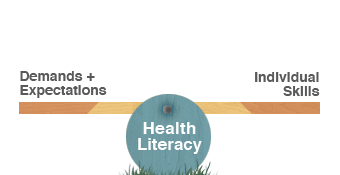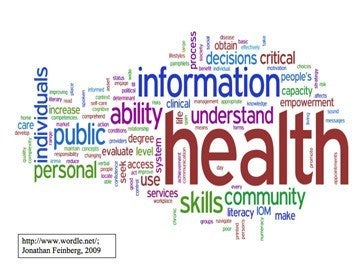Health Literacy emerges from an interaction between system demands and people’s skills.

graphic by Dalen Gilbrech
Overview of the Field
A Plea for Clarity
Slide Presentation
Video
Chart of Health Literacy Related Health Activities, Materials and Task
Overview of the Field
What is Health Literacy?
Definitions offer more than statements of meaning. They demarcate scope and parameters of words and ideas. In the case of health literacy, definitions have shaped questions for research and offered guidelines for measurement. They have also indicated a locus of control and responsibility that has influenced practice and policy decisions.
Unfortunately, the term health literacy has been frequently used to focus on the skills of individuals alone without attention to the demands and assumptions, the words and texts, as well as the social factors and contexts that shape skills and abilities.

Although the literacy and verbal skills of individuals are of critical importance, so too are the demands made by the health materials themselves, the communication skills of those in the health field, and the complicated nature of the healthcare and public health systems.
Rima Rudd
Objective 11-2: Improvement of Health Literacy
Communicating Health, USDHHS, 2003
Health literacy is a shared function of social and individual factors. Individuals’ health literacy skills and capacities are mediated by their education, culture, and language. Equally important are the communication and assessment skills of the people with whom individuals interact regarding health, as well as the ability of the media, the marketplace, and government agencies to provide health information in a manner appropriate to the audience.
Health Literacy: A Prescription to End Confusion
The Institute of Medicine, 2004
Only recently have we professionals looked in the mirror to consider our communication skills and how we support or impede the public’s health literacy. While a great deal of attention has been given to the development and testing of individuals’ health literacy skills, little attention has been given to the development and testing of professionals’ skills, to measures of the complexity of health tasks, or to analyze the intricacies of public health and health care institutions.
Our field of study will expand as we move forward with attention to links between literacy-related demands of health systems and the public’s access to information, tools, and health care and as we consider health literacy as an issue of social justice.
The health sector is multifaceted and complex. Substantive literacy skills are needed if one is to successfully navigate health and healthcare systems in today’s societies. However, adults are often provided with unnecessarily complex materials that do not function as the tools for action and aids for decision-making they are meant to be. In addition, many health professionals have grown accustomed to writing and speaking a specialized language that relies on the jargon of their work rather than on the common words of everyday exchanges. Communication is often hampered by the written and spoken word.
A substantial body of literature in public health and medical journals offers evidence of a link between poor reading skills of study participants and a wide array of poor health outcomes. However, we cannot logically attribute poor reading to poor health. Well over 1,000 articles also attest to the high demand of health materials in print and on web sites. Clearly, our argument must be based on the mismatch between the literacy related demands of health information and care systems and the literacy skills of the population. This mismatch is unnecessary as is the well documented morbidity and mortality that results. We must consider how we can align demands and expectations with well measured skills.
Below we offer a slide presentation, video, and chart that will help introduce you to the field of health literacy. We hope these tools will provide you with an overview and background information for further explorations of health literacy issues relevant to your work. The remaining pages of this website provide more in depth resources on specific facets of health literacy such as the research findings, policy reports, practice guides and more.
Rima E. Rudd, 2010
A Plea for Clarity
“This is Bad Enough” by Elspeth Murray
Slide Presentation
A health literacy overview is offered as Microsoft PowerPoint slide presentation. This presentation was created by Rima Rudd and colleagues at the Harvard School of Public Health.
We hope this introductory slide presentation will serve as background information for further explorations of health literacy issues relevant to your work.
Citation: Rudd RE. Literacy and implications for navigating health care. Harvard School of Public Health: Health Literacy Website. 2010. Available at https://www.hsph.harvard.edu/healthliteracy/overview/. Accessed “insert date.”
Video/DVD : In Plain Language
In Plain Language was produced by Dr. Rima Rudd and Dr. William DeJong, with a team of Health Literacy Studies professionals and researchers. This 15-minute video/DVD was developed for medical and public health professionals who are interested in learning about adult literacy in the US and implications for medicine and for public health.
The video/DVD includes testimonials from adult learners about meeting literacy demands in health care settings. In Plain Language can be used as a starting point for courses, workshops or conferences addressing health communication issues. Suggested follow-up activities include activities related to writing and speaking in plain language.
Production of the video/DVD was supported by the Pfizer Corporation through an unrestricted educational award and through the Educational Research and Development Centers Program (Award Number R309B60002), as administered by the Office of Educational Research and Improvement/National Institute of Postsecondary Education, Libraries, and Lifelong Learning, U.S. Department of Education. Please note that this DVD was produced in the 1990’s, before the NAAL was launched in 2003.
Chart of Health Literacy Related Health Activities, Materials and Tasks
Literacy and Health in America offers a schema for examining health materials, tasks, and skills within five commonly used groupings: health promotion, health protection, disease prevention, health care and maintenance, and navigation. The table linked below offers a brief description of each of these groups of activities with examples of a range of materials that adults use and the associated tasks they undertake.
Chart of Health Literacy Related Activities, Materials and Tasks



